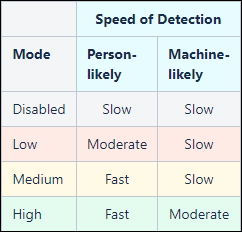In short, I don't think machine tone updates will be relevant to your issue.
There is no action required to benefit from that call analysis model update. If the machine tone is seen, then it will be detected. If the Call Analysis Response for the campaign has Beep Detection disabled, then it is unlikely that a machine tone will even be reached, since a machine is typically detected quickly during the message greeting. When Beep Detection is enabled, then the call will proceed until the beep (machine tone) is reached. If the beep is being detected as Live Voice for you (which is highly unlikely), then this model update would be directly relevant.
Which mode of ALSD is set on the Call Analysis Response (disabled, low, medium, high)?
If it is disabled, then the machines that are being detected as Live Voice are likely short name prompts or personal machine greetings (less than ~2.2 seconds long), which would be a part of the expected error rate. You can confirm the greeting length by downloading the call recording (if enabled) and opening it in a program that allows you to view the duration (for example, Audacity).
If ALSD is not disabled, then there could be a number of reasons for why a machine is being detected as Live Voice (depends on the mode and in-country ringback patterns). I would suggest opening a customer care case for investigation.
Original Message:
Sent: 11-20-2023 20:08
From: Gary Kao
Subject: Regional Rollout of Pure-4000: Adjustable Live Speaker Detection
Hi Jason,
Thanks for reply.
We also seem the Media Tier release notes for Version 1.0.0.13060 – October 18, 2023, it said the Call analysis model updates to detect 1950Hz machine tones. Does this relevant to the our issue? Does this need to be adapted to each country's environment? How to adjust it?
Gary.
------------------------------
Gary Kao
Grandsys Inc.
Original Message:
Sent: 11-20-2023 11:19
From: Jason McDowell
Subject: Regional Rollout of Pure-4000: Adjustable Live Speaker Detection
Hello Gary,
The highest accuracy between person vs machine detection will be found with the ALSD mode disabled. When ALSD mode "Low" is enabled, then the speed to person detection will be faster but at a cost to machine accuracy (since we have less audio to determine if it is a person vs machine). Medium and High modes will be very fast but also significantly lower accuracy. We are working on more detailed resource center documentation to further explain the behavior.
------------------------------
Jason McDowell
Genesys - Employees
Original Message:
Sent: 11-20-2023 11:05
From: Gary Kao
Subject: Regional Rollout of Pure-4000: Adjustable Live Speaker Detection
Hi All,
I'm a partner in the Asia Pacific (Tokyo) region, and our customer has an Agentless outbound mode misjudgement issue. They have some calls are answered by personnel, but they are judged to be answered by machines. Is there any place that can be adjusted?
Gary.
------------------------------
Gary Kao
Grandsys Inc.
Original Message:
Sent: 10-05-2023 14:58
From: Jason McDowell
Subject: Regional Rollout of Pure-4000: Adjustable Live Speaker Detection
"I see this in US-EAST-1, so does that mean it is deployed there?"
That's correct.
"Do you have timeline for complete deployment?"
Tests are passing for SAE1 (Sao Paulo), and we are currently planning to release on October 18th.
We found that there is a strong correlation between the number of ringbacks detected by the time live speakers answer the call (1-3 rings), so Person-likely represents 1-3 ringbacks were detected (Machine-likely would be 0 or 4+ ringbacks). This is the initial default globally, however, we have the ability to tune this over time according to each regions needs.
Each mode applies Person-likely heuristics more aggressively (in terms of speed to live speaker detection) as it increases from Low to High, which also decreases accuracy in favor of speed to live speaker detection.
Low mode: If Person-likely, then on post-connect generic speech detection (200-300ms of speech), a live speaker is detected early. If the speech is a known audioprint (pre-recorded carrier voicemail message or busy message) with a strong match, then early live speaker detection is correctly avoided and the machine or busy is detected via the audioprint. Standard timings if Machine-likely.
Medium mode: If Person-likely, then on line connect, a live speaker is detected early. Standard timings if Machine-likely.
High mode: If Person-likely, then on line connect, a live speaker is detected early. If Machine-likely, then a live speaker is detected on post-connect generic speech (same rules apply as the low mode to this)
------------------------------
Jason McDowell
Genesys - Employees
Original Message:
Sent: 10-01-2023 12:58
From: Robert Wakefield-Carl
Subject: Regional Rollout of Pure-4000: Adjustable Live Speaker Detection
I see this in US-EAST-1, so does that mean it is deployed there? Do you have timeline for complete deployment? Also, can you elucidate on the description in the resource center? This is all we have, but what exactly is each setting looking at? What is the meaning of Person Likely and what does it look at?
The speed of detection for a person most likely detected or a machine most likely detected can be selected for the following modes.
 Disabled (None) No change to current settings
Disabled (None) No change to current settings
------------------------------
Robert Wakefield-Carl
ttec Digital
Sr. Director - Innovation Architects
Robert.WC@ttecdigital.com
https://www.ttecDigital.com
https://RobertWC.Blogspot.com
Original Message:
Sent: 09-21-2023 10:20
From: Chad McCormick
Subject: Regional Rollout of Pure-4000: Adjustable Live Speaker Detection
Due to an issue with our testing tool in the SA-E region, we will be releasing this feature in all regions except for SA-E. Although the feature is working as expected in that region, our tests are not passing. We are working to resolve the issue and expect to have it fixed in the next few weeks.
#Outbound
------------------------------
Chad McCormick
Genesys - Employees
Senior Product Manager, Outbound Solutions
INUnited States
------------------------------